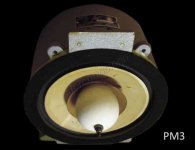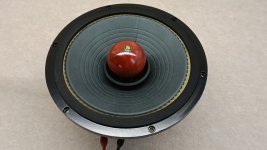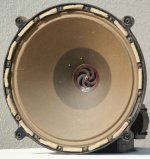Here is a DIY article on removing the dust cap from a speaker and replacing it with a Phase Plug....I think some might find it educational....
http://rvbprecision.com/stereo/full-range-speaker-phase-plug-addition.html
http://rvbprecision.com/stereo/full-range-speaker-phase-plug-addition.html
Last edited by a moderator:
Interesting. We have been doing that for decades.
Most small drivers benefit from other treatment to the dustcap, but every whizzer cone driver (+ the Visaton B200) benefit greatly from a phase plug.
https://www.planet10-hifi.com/pp-info.html
dave
Most small drivers benefit from other treatment to the dustcap, but every whizzer cone driver (+ the Visaton B200) benefit greatly from a phase plug.
https://www.planet10-hifi.com/pp-info.html
dave
Last edited:
Yeah, Chrome, Avast 'say's not secure, but neither seem to have any issues with me browsing through some of its links, so FWIW/YMMV.
I would be interested to know when a FR benefit from having a phase cone vs dust cap and vice versa if someone knows.
As premium FR can be found with dust cap and cheaper FR found with phase cone I don't buy the story that phase cone means always better, seems too black or white.
As premium FR can be found with dust cap and cheaper FR found with phase cone I don't buy the story that phase cone means always better, seems too black or white.
They're not really phase plugs in the original sense of the term (although there is a connection to phase) -they're more pole-piece extensions. It depends on the driver, so there isn't a single answer, but FWIW, if you take something like a single-cone Alpair, the cap is direct-bonded to the end of the coil; functionally it acts like a dome or equivalent profile tweeter, with the main cone being more or less (depending on design) progressively decoupled as frequency rises. The chosen profile depends heavily on the geometry of the main cone, surround etc. plus the usual bunch of other factors specific to the individual unit. Not all single-cone drivers take this approach of course, so you'll sometimes see plugs of varying profiles -especially if the cone and / or suspension is relatively deep, as that can (can 😉 ) start causing cancellation effects as / when the transverse wave reflects back from the surround toward the coil; it can also help with off-axis, since with the deeper profiles you're potentially getting progressive phase related cancellations in the midband / HF as parts of the cone blank each other. Same (even more) applies to drivers with multiple cones etc. as parts blank each other off or otherwise interact. They can also have other advantages -preventing 'oil can' resonance in a hollow (especially unvented) pole-piece, and with alloy types, they are sometimes used as additional heatsinks for the VC.
Last edited:
Thanks for the clear answer Scott.
I feel only phase cones can be a big enough topic to write a book 😵
In the FR brands there is quite a lot of shapes for the phase cone that can be found. From really rational Mark Audio stuff as you mentioned to some more esoteric / exotic materials. Wondering if they are all functional or if some of them enter that decorative side of the spectrum even degrading the audio somehow.
Here few pictures / Fertin / Lowther / Lii Audio / Siemens (klangfilm)
Sorry if i am off topic...But this can add to why adding a phase cone i hope.
I feel only phase cones can be a big enough topic to write a book 😵
In the FR brands there is quite a lot of shapes for the phase cone that can be found. From really rational Mark Audio stuff as you mentioned to some more esoteric / exotic materials. Wondering if they are all functional or if some of them enter that decorative side of the spectrum even degrading the audio somehow.
Here few pictures / Fertin / Lowther / Lii Audio / Siemens (klangfilm)
Sorry if i am off topic...But this can add to why adding a phase cone i hope.
Attachments
No worries. 🙂
Oh yes, some are simply aesthetic -especially those fixed to the cone rather than being static. 😉 Profiles -YMMV; depends on the on / off axis FR you're aiming for, and there the design & profile of the cone / cones, surround etc. come into play. And there are sometimes different ways of achieving the same (or similar) ends. Some of the material aspects may be aesthetic or in keeping with a general theme; sometimes they might serve double functions like heat-sinks as alluded to. I remember a polystyrene or some such design that was used for damping a specific frequency -what the driver was I don't recall though. Ditto for a rubberised job that looked like a refugee from a squash court (and might have been for all I know...). The most interesting example I can think of wasn't really a plug at all: it was just a piece of drilled-out dowel rod used to coaxially mount a tiny neodymium tweeter. I think a few tried that with the old Pioneer B20.
Oh yes, some are simply aesthetic -especially those fixed to the cone rather than being static. 😉 Profiles -YMMV; depends on the on / off axis FR you're aiming for, and there the design & profile of the cone / cones, surround etc. come into play. And there are sometimes different ways of achieving the same (or similar) ends. Some of the material aspects may be aesthetic or in keeping with a general theme; sometimes they might serve double functions like heat-sinks as alluded to. I remember a polystyrene or some such design that was used for damping a specific frequency -what the driver was I don't recall though. Ditto for a rubberised job that looked like a refugee from a squash court (and might have been for all I know...). The most interesting example I can think of wasn't really a plug at all: it was just a piece of drilled-out dowel rod used to coaxially mount a tiny neodymium tweeter. I think a few tried that with the old Pioneer B20.
especially if the cone and / or suspension is relatively deep, as that can (can 😉 ) start causing cancellation effects as / when the transverse wave reflects back from the surround toward the coil; it can also help with off-axis
Visaton B200 is a very good example of that.
dave
The most interesting example I can think of wasn't really a plug at all: it was just a piece of drilled-out dowel rod used to coaxially mount a tiny neodymium tweeter.
Had all the pieces to do that with Eminence 12LTA. But a VC big enuff to mount an FT17.
dave
- Home
- Loudspeakers
- Full Range
- Adding a PHASE PLUG to a FR Speaker



